At a time when many museums around the world are faced with an existential crisis, the museum sector in China seems to be alive and growing. In Part 1 of a series, Chitralekha Basu examines how the pandemic and a whole panorama of other challenges that intensified in its wake affected new and upcoming museums in the Bay Area.
 Visitors are stirred into embracing a spirit of discovery at Design Society in Shekou, Shenzhen, says museum director Ole Bouman. (PHOTO COURTESY DESIGN SOCIETY)
Visitors are stirred into embracing a spirit of discovery at Design Society in Shekou, Shenzhen, says museum director Ole Bouman. (PHOTO COURTESY DESIGN SOCIETY)
Even without the pandemic playing havoc with their plans, museum directors of today have their task cut out for them. More often than not, they are expected to take on an ambitious range of civic responsibilities that go beyond being custodians and exhibitors of art and heritage. And the list keeps growing.
For example, museums today are expected to make room for diversity in what they show and who they hire. Using energy-efficient systems and embracing recycling is a given. Then so is protecting items from the museum collection that are particularly fragile and whose safekeeping will cost humongous amounts of electricity.
A museum of today is expected to empathize with people with special needs and rock with the trendy. And while they are at it, they must also reach out to the underprivileged sections of society, provide free Wi-Fi to make sure the crowds feel at home and go on road shows to promote their cause and seek new audiences.
According to a definition of museums proposed to International Council of Museums (ICOM) in September 2019, museums should be accountable to the public (“they hold artifacts and specimens in trust for society”), demonstrate political awareness (“addressing the conflicts and challenges of the present”), and “aim to contribute to human dignity and social justice, global equality and planetary well-being.”
 Artwork created by KAWS for Mirage, an app-based curated augmented reality group show, co-produced by Acute Art and UCCA, Beijing. (PHOTO PROVIDED TO CHINA DAILY)
Artwork created by KAWS for Mirage, an app-based curated augmented reality group show, co-produced by Acute Art and UCCA, Beijing. (PHOTO PROVIDED TO CHINA DAILY)
Suhanya Raffel, the director of M+ — Hong Kong’s much-awaited museum of visual culture scheduled to open in West Kowloon Cultural District in 2021 — points out that although the proposed definition left out key ideas museums are concerned with such as “art” and “learning”, it was “a reflection of the changing role of museums in many parts of the world and the way this is perceived by the communities that we serve.”
Raffel is among the 28 museum directors from around the world New York-based arts writer and cultural strategy consultant Andras Szanto interviewed in his recently-published book — The Future of the Museum: 28 Dialogues (Hatje Cantz). Their views on the theme seem to align.
Szanto agrees the conversation around whether museums should extend their “traditional functions — to collect, preserve, research, interpret, exhibit” and take on an “expanded role as an agent of community life and social progress” has been an ongoing one that “intensified in the wake of the coronavirus pandemic.”
“This strange moment has crystallized an awareness that some things needed to change,” he says.
 Qing Dynasty glass vase dated between 1736 and 1795 from Hong Kong Museum of Art collection. All 17,000 sets of items from the museum’s collection are available to view online. (PHOTO PROVIDED TO CHINA DAILY)
Qing Dynasty glass vase dated between 1736 and 1795 from Hong Kong Museum of Art collection. All 17,000 sets of items from the museum’s collection are available to view online. (PHOTO PROVIDED TO CHINA DAILY)
Digitization drive
Museums in Hong Kong, now closed for the fourth time, owing to a fresh surge of coronavirus cases in the city, had responded to the strangeness of the moment early on, almost as soon as the first shutdown of public cultural facilities in January 2020. Their staff, who spent much of the year working from home, have digitized massive amounts of museum collections and exhibitions and put them online, often at an astounding pace.
Maria Mok, director of Hong Kong Museum of Art, says the museum “uploaded our entire collection comprising 17,000 sets of items online by March 30.” The museum’s online digital platform for showcasing multimedia content, virtually@HKMoA, has received 1.6 million visitors until the end of November 2020, she informs.
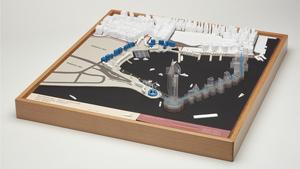 Hong Kong architect Tao Ho’s site model, Metroplan West Kowloon Reclamation Concept, 1988, from M+ collection. (PHOTO PROVIDED TO CHINA DAILY)
Hong Kong architect Tao Ho’s site model, Metroplan West Kowloon Reclamation Concept, 1988, from M+ collection. (PHOTO PROVIDED TO CHINA DAILY)
Avid museum sector watcher, Selina Ho, who is a research assistant professor in the Department of Visual Studies, Lingnan University, however, feels the volume of museum content posted online to provide homebound audiences with an alternative to the physical experience by various Hong Kong museums was not always matched by the quality of innovation. Most of them, she says, used “their virtual spaces (merely) as an online repository or database. They could have done better by inventing interactive tools and creative spaces to engage direct and inspiring online experiences.”
The digital efforts that did stand out in the crowd, Ho says, are those by Centre for Heritage, Arts & Textiles (CHAT) and M+. “They are among the few that organized livestream dialogues with artists and curators.”
In fact, CHAT got nominated by International Committee for Museums and Collections of Modern Art for the Outstanding Museum Practices in a Time of Global Crisis award, having demonstrated the ability to come up with “innovative solutions and inspiring practices” adopted to counter the crises brought on by the pandemic.
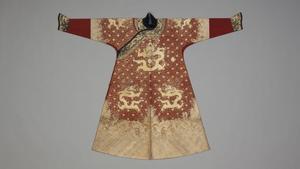 Festive robe with dragons, 12 imperial emblems and lotus scrolls, from Qing Dynasty, Qianlong period (1736-1795), from Palace Museum collection. (PHOTO COURTESY PALACE MUSEUM)
Festive robe with dragons, 12 imperial emblems and lotus scrolls, from Qing Dynasty, Qianlong period (1736-1795), from Palace Museum collection. (PHOTO COURTESY PALACE MUSEUM)
“In these uncertain times new institutions like us struggle to find the right model to adapt and follow,” says Mizuki Takahashi, executive director and chief curator of CHAT. Inspired by the communal history of textile making, involving a variety of skill sets and knowledge sources, Mizuki launched an online international partnership project, Textile Culture Net, in May 2020, with three other textile institutions — Central Museum of Textiles in Lodz, Poland, Lottozero in Prato, Italy, and TextielMuseum in Tilburg, Netherlands. By November 2020 the institutes were sharing know-how and exhibitions on their IG platforms.
“Opening a platform to share the burdens of these new challenges and producing content collectively is quite an important act of support for one another,” Takahashi says, adding that she had to “learn from scratch how to make the most use of our digital space and technology,” in order to find a niche in a highly-competitive global online pitching scenario.
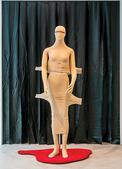 Exhibit made out of recycled clothing from Yin Xiuzhen’s ongoing show at Centre for Heritage, Arts & Textiles. (PHOTO PROVIDED TO CHINA DAILY)
Exhibit made out of recycled clothing from Yin Xiuzhen’s ongoing show at Centre for Heritage, Arts & Textiles. (PHOTO PROVIDED TO CHINA DAILY)
Different strokes
The story is somewhat different in Shenzhen. By the end of March 2020, the city had come to grips with the pandemic and its museums were ready to welcome their patrons back to their premises, although there was a cap on the number of visitors per day.
Ole Bouman, who is the founding director of Design Society museum in Shekou, Shenzhen, says he was delighted to see the crowds returning to the Sea World Culture and Arts Center where the museum is located, “not just as visitors, but explorers” of the Fumihiko Maki-designed development, taking advantage of its gorgeous green rooftops, external staircases and the sprawling lawns along the waterfront dotted with massive cheerful sculptures that they could sit on, climb or crawl under.
Being a hugely tech-driven culture, and because the pandemic-triggered restrictions on physical mobility have been lifted, the museums on the Chinese mainland can now use their digital expertise in ways other than trying to create virtual museum tours for visitors stuck at home.
 Leigh Tanner of Museum 2050 says museum audiences in the Chinese mainland adapted fast to online programing. (PHOTO PROVIDED TO CHINA DAILY)
Leigh Tanner of Museum 2050 says museum audiences in the Chinese mainland adapted fast to online programing. (PHOTO PROVIDED TO CHINA DAILY)
“The cultural landscape in China is in many ways inextricably intertwined with digitization due to the manner in which WeChat and other digital platforms are part of the everyday,” says Leigh Tanner, co-founder, Museum 2050 — a platform for studying the cultural and social impacts of the museum boom in China in the last decade. “As a result, we were uniquely prepared for the pandemic as audiences feel comfortable with online programing, livestream feeds and connecting via the virtual,” Tanner remarks.
Citing Mirage — a jaw-dropping app-based augmented reality show featuring works by genre pioneer Olafur Eliasson, KAWS and Guangzhou’s own Cao Fei, currently running in Beijing’s UCCA Center for Contemporary Art — as a fine example of the heights that tech-driven art can touch, Tanner says, “such exhibitions have a place with or without the pandemic.”
“Even as we (on the Chinese mainland) are able to visit museums, attend lectures and travel domestically, this form of content continues to resonate with audiences in this moment and has the benefit of accessibility,” she adds.
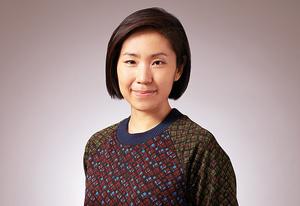 Shirley Surya, curator, design and architecture, M+, says the pandemic made her question the impact of her curatorial work. (PHOTO PROVIDED TO CHINA DAILY)
Shirley Surya, curator, design and architecture, M+, says the pandemic made her question the impact of her curatorial work. (PHOTO PROVIDED TO CHINA DAILY)
Social responsibility check
Louis Ng, the director of Hong Kong Palace Museum (HKPM), says he supports social justice-driven policy decisions adopted by museums such as creating space for better representation of women and trying to reduce their carbon footprint, and HKPM will embrace both of the above among a range of other socially-conscious measures when it opens next door from M+ in 2022.
“However, while I agree that such activities are part of HKPM’s agenda, I think they should not be the core,” says Ng. “If it became our core business we’ll lose our fundamental function, which is to preserve and showcase our cultural heritage. That’s number one.”
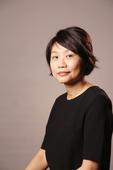 Lingnan University academic Selina Ho feels Hong Kong museums can make better use of their virtual spaces. (PHOTO PROVIDED TO CHINA DAILY)
Lingnan University academic Selina Ho feels Hong Kong museums can make better use of their virtual spaces. (PHOTO PROVIDED TO CHINA DAILY)
HKPM will be a sibling institution to Beijing’s Palace Museum, looking at samples of ancient art and artifacts sourced from the latter through the lens of a fresh curatorial approach that Hong Kong audiences can relate to, says Ng, adding young Hong Kong visitors might even find some of the things that once belonged to Chinese royalty resonating with their own sense of fashion.
While re-interpreting the past is what seems to drive HKPM’s vision, trying to derive meaning and a sense of direction from the present confusion is also on the agenda of professionals developing content for Hong Kong’s upcoming museums.
“The challenge seems to lie in rethinking the kind of content we are developing,” says Shirley Surya, curator, design and architecture, M+. “With the loss of lives, separation from loved ones and rise of unemployment, there’s a need to make sense of, and build empathy for, human frailty, mortality, and the baseline priorities of our lives.”
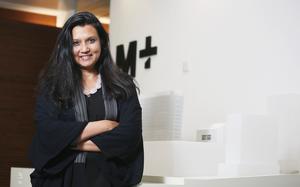 M+ museum director Suhanya Raffel believes practicing social justice is part of a museum’s civic responsibility. (PHOTO PROVIDED TO CHINA DAILY)
M+ museum director Suhanya Raffel believes practicing social justice is part of a museum’s civic responsibility. (PHOTO PROVIDED TO CHINA DAILY)
If 2020 is a watershed year when an epoch ends and another begins, all eyes are on M+ which is expected to commission and present new works that speak to a historical moment beyond which our lives will never be the same again.
“At M+, we will embrace these new references and frameworks as we continue to plan our programs and build our collection,” says Surya. “Yet can we do so without performatively demonstrating relevance, monetary worth, productivity, or moral hubris in our work, especially at a time when we should perhaps listen more, rethink existing assumptions, and expand our criteria for assessing the value and meaning of artworks? Our speed of production, excessive performativity, and press-oriented blockbusters all come under question.”
The big pause brought on by the pandemic has created a space for museum professionals to question existing curatorial approaches and cultivate empathy. By the time the city’s new museums are ready to launch, they will probably have worked out creative ways to act on what they are feeling.
Click here to read a Q&A with Suhanya Raffel, museum director, M+ museum
Contact the writer at basu@chinadailyhk.com


